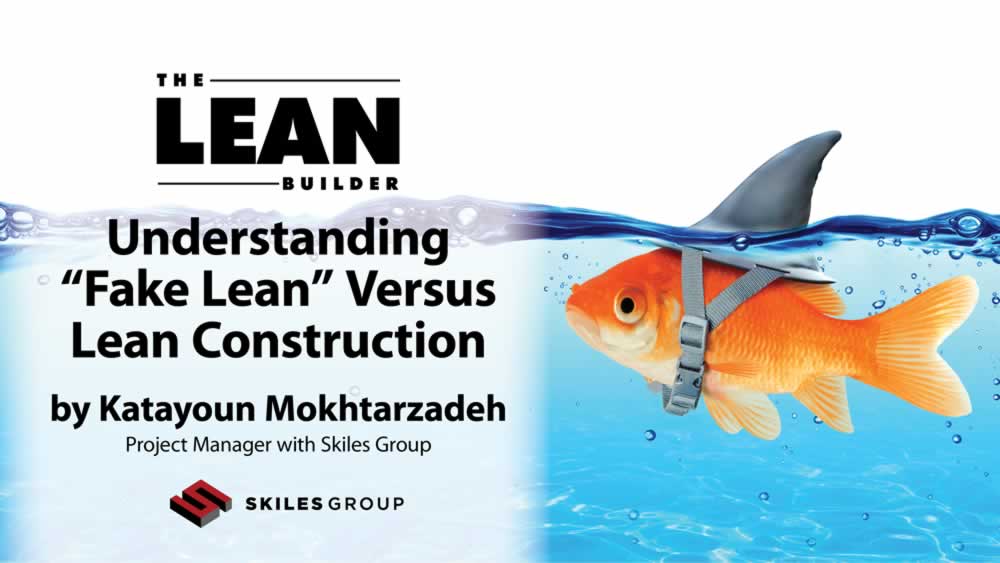Although Lean Construction was first applied in 1993, the concept itself is commonly traced back to Henry Ford and Toyota in the 1900s. Despite 30 years of implementation, too often organizations tout using Lean Construction without actually following Lean practices, thus the term fake Lean.
Have you heard of “Fake Lean”?
Fake Lean is when organizations say they are “using” Lean practices on a job site, but essentially, they are not. The idea usually ends right at the pull plan with sticky notes on a board in the main huddle room. Unfortunately, they collect dust as the master schedule is updated separately, by the master scheduler with zero regards to the operations team’s pull plan.
Fake Lean also happens when the contractor hires trade partners and subcontractors who do not believe in Lean and only check boxes on a list to adhere without buy-in. Yet, somehow the team is still shocked the project did not go as planned. Or worse, trade partners join the team to be on a Lean project and realize the general contractor (GC) has no intention of truly being Lean, and the Lean journey ends at the sticky notes.
Is your team practicing fake Lean?
Here are some strong indicators that you might be:
- Team culture: Has the team fully bought into the why behind Lean? Is the entire team on board, or does it only have one driver? Is Lean a requirement from the owner, or is it a true choice? Does the organization apply Lean internally, as well as externally, or is it only used on this one job?
- Trade partners: Do they truly believe in Lean, or is it a show to meet contract requirements? Have their teams been trained on what it truly means to be Lean and what practices are to be included? This is also why it is critical to award projects based on the people and team involved and not necessarily the lowest budget.
- Training: How far does your internal training go, and to what level are your teams trained? Who is being trained? Is Lean extended only to team leaders, or does everyone have an opportunity to learn and practice? How well are they being trained and how thoroughly? This question can be applied to trade partners as well. If you are truly passionate, and your trade partner is honest about their knowledge level, you can conduct onsite training as you go through the levels of Lean and teach them, too, which increases value.
- Milestones: To what extent do you hold milestones firm? Do you hold your teams accountable to them? If they shift, do you realign as a team or do you expect other trades to make up time on the backend or run fire drills to support you? Do you plan your milestones, hold weekly meetings, and conduct daily huddles? Do your trade partners understand the commitment and planning process to understand their submitted dates are the final schedule and that any shift would require a secondary pull plan?
- Communication: Are your crews involved in creating the pull plan and master schedule? Is everyone aligned with what the tasks and goals are? Do you have the right people in the room at the start to make the plan and the corresponding commitments? Are you having open, consistent communication and promoting a commitment to continuously learn and improve? Are you honestly discussing PPC variances and constraints that impact the entire team? Are you identifying and removing constraints? Are you employing the EOR/ARCH to help with this process and holding them accountable as well?
Moving Away from Fake Lean
Teams who employ true Lean practices and embody this approach in their day-to-day work life realize many benefits:
- Increased productivity,
- Less rework,
- Less trade stacking,
- Better flow, and
- Less hours.
What can help you move in this direction? One of the most beneficial steps is to get a coach to truly learn what it means to practice Lean vs fake Lean. The Lean Builder provides a great framework to start your Lean journey.
Other steps that I’ve found helpful to promote Lean include:
- Commit to all the levels within Lean. Practicing only one level does not make you a Lean practitioner.
- Get buy-in. Aim for buy-in on resolution and even include your EOR/ARCH/Owner in this process to share the ownership. Getting buy-in from your leadership team is critical. Educate them on the benefits and use a pet project as the sample to win their confidence.
Get passionate! Engage, learn, and grow within the Lean community. Passion is infectious and can motivate the team to be passionate about Lean, as well.
Be sure to follow Katayoun Mokhtarzadeh on LinkedIn!
Related Blogs
The Power of Visual Communication









